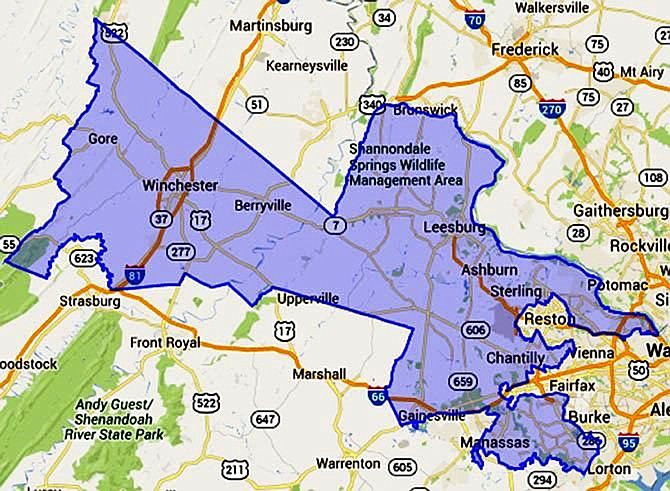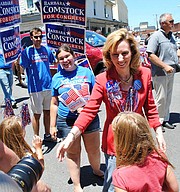Virginia’s sprawling 10th district, originally created in 1952, stretches from inside the Capital Beltway in northern Virginia west to the Shenandoah Valley. Source: VPAP
Money
Both Foust and Comstock have received and spent millions of dollars in the race to replace retiring Congressman Frank Wolf (R). Congressional candidates are required to file up to seven main reports with the Federal Election Commission during the 2014 midterms. Below are Foust and Comstock’s most recent quarterly reports, filed Oct. 15.
*Comstock:
Beginning Balance: $575,890.52
Total Contributions for Reporting Period: $1,300,412.84
Expenditures: $1,075,722.43
Cash on Hand: $800,580.93
*Foust:
Beginning Balance: $1,125, 718.40
Total Contributions for Reporting Period: $1,008,833.03
Expenditures: $1,492,681.95
Cash on Hand: $641,869.48
Source: http://Ballotpedia.…">Ballotpedia.org
The race to replace U.S. Rep. Frank Wolf (R) in Virginia’s sprawling 10th district has been exactly what political prognosticators said it would be: one of the most watched, most expensive and most contested races in the 2014 midterm elections.
For years, local Democrats liked to joke that the seat was not so much an “R” seat as a “W” seat, and if they could field a candidate named Wolf, they would have the seat regardless of party affiliation.
But they didn’t expect a shot at the seat anytime soon.
Until last December, when Wolf delivered a game-changer by announcing that he would not seek re-election to an 18th term in Congress.
His retirement announcement came as a surprise to both Republicans and Democrats, and set off a feeding frenzy among political hopefuls throughout the district.
By the end of January 2014, 15 candidates stood in line for a chance at the coveted seat.
The news also sparked a flurry of speculation about the district’s possible political shift. Democrats became bullish on the seat that had not been competitive for 30 years.
In February, The Rothenberg Political Report rated the race as “leans Republican,” noting that in recent elections, the district supported both Republicans and Democrats in presidential and gubernatorial races. The Washington Post ranked the seat as “the sixth most likely seat to flip control” in the 2014 election.
“The 10th district had become increasingly liberal and diverse,” said Toni-Michelle C. Travis, an associate professor of government and politics at George Mason University. She noted that while Democrats held just three congressional districts, voters swept Democrats into all three statewide offices last year, and went for President Obama twice.
“These districts are shifting and they are not set in stone anymore,” Travis said. “The 10th now includes a chunk of Loudoun County, and voters are going to see the world differently from voters in Fairfax County. It’s possible that’s where the race will be won or lost.”
IN REACTION to the news of an open seat, both parties were frantically maneuvering to select a candidate. Many Democrats were already coalescing around Fairfax County Supervisor John Foust, who had announced his candidacy in September to run against the incumbent Wolf.
“I remember being in the Government Center when Wolf announced his retirement … my Blackberry started buzzing like crazy. I was surprised, but I knew my chances to win just shot up,” Foust said.
On Jan. 24, Northern Virginia Republicans announced the party would run a firehouse primary on April 26 to choose a nominee. The firehouse primary had never been tested in the state’s congressional history, and it was a process that caused significant intra-party strife. But it would give their nominee an early start. If the party opted for a state-run primary or convention, it would not have been held until June 10.
In reaction, Fairfax County Democrats announced in March they would cancel a convention, and select Foust as their nominee.
Avoiding a costly primary would give Democrats an edge in building widespread district support for Foust before Republicans named their nominee in a firehouse primary in April.
State Del. Barbara Comstock handily won the GOP “firehouse” primary in April. The former Wolf aide and establishment favorite beat out five other contenders for the nomination.
Her win ensured a heated general election contest for the battleground district, and signaled the official start of the high-stakes race.
For the past six months, both candidates have been campaigning hard.
Foust’s campaign likes to look at the race in terms of numbers. They boast that the campaign has made 960,000 phone calls, knocked on 120,000 doors and registered 1,500 new voters in the quest for the seat.
But the midterm cycle is a steep climb for Democrats, and a win often comes down to a vigorous get-out-the-vote effort.
Republicans, outflanked by a superior Democratic turnout operation in the past two presidential elections, have been spending tens of millions of dollars to improve data collection to achieve a rough parity.
President Obama’s approval ratings are hovering near all-time lows, and Republicans have successfully persuaded their core supporters that the election is a referendum on him.
IN EARLY OCTOBER, National Democrats delivered a blow to Foust by canceling a multimillion-dollar television ad buy in the race, shifting money from the 10th to shore up vulnerable incumbents, such as freshman Rep. Ami Bera, a California Democrat.
“Ad reservations are changing every week, and John Foust is running an aggressive campaign in a tough climate,” David Bergstein, spokesman for the Democratic Congressional Campaign Committee, said in response to the move.
Foust said he still sees a path to victory. Campaigning Saturday in Prince William County, Foust told supporters that the campaign is at a “critical point.”
“I like to say both Barbara Comstock and I will have more than enough supporters to win this election, there’s no question about that. But because it’s a low turnout election, the one who is going to win is the one who has the ground game, and I know we have the ground game.”
Comstock’s campaign said they have been working their field operation too.
“As we enter the final week, our campaign has the momentum,” Comstock said Friday. “We have ongoing Get Out The Vote efforts and will continue to reach voters through Election Day. I am pleased with all of the positive responses we get every day throughout this diverse district.”
Johanna Persing, a spokesperson for Comstock’s campaign, said Comstock and her volunteers have been knocking on doors every day. “We are reaching voters in all corners of the district… our strong ground game and Get-Out-the Vote effort will be instrumental to victory on Nov. 4.”
“The point is not everything is moving in one direction. Different groups are responding in different ways to the candidates and the message,” said longtime campaign activist Frank Blechman of Fairfax. “Bottom line: It’s too close to call so get out and vote.”


